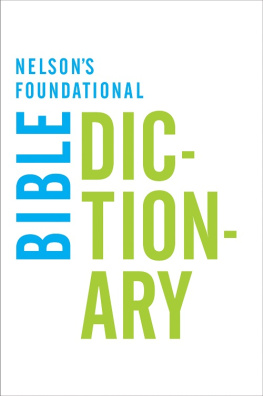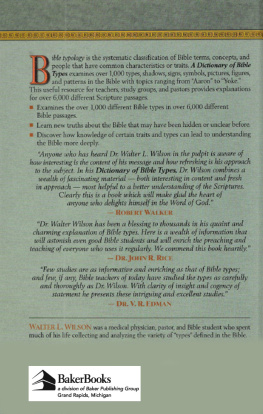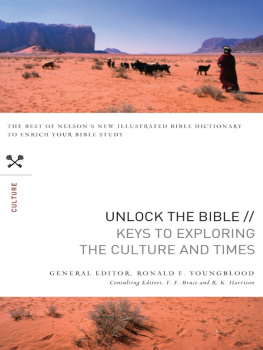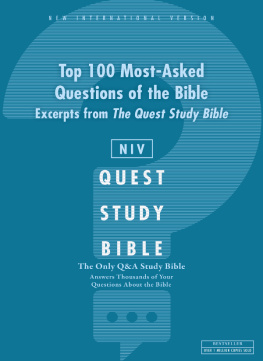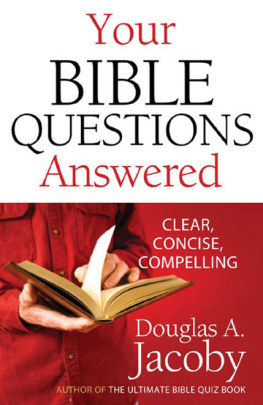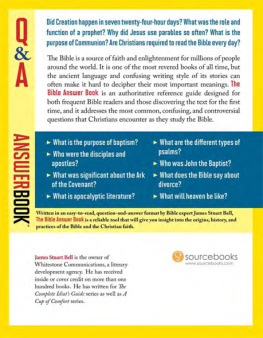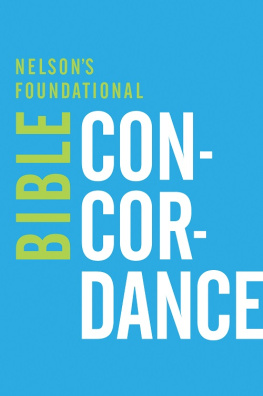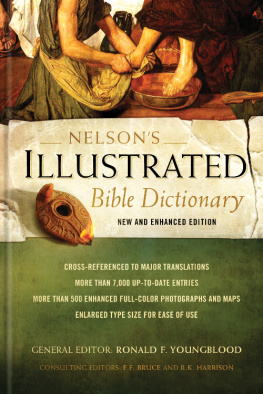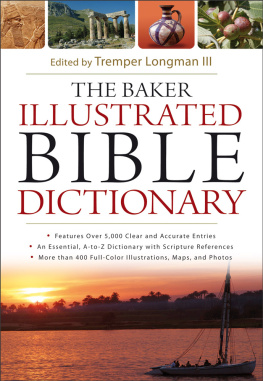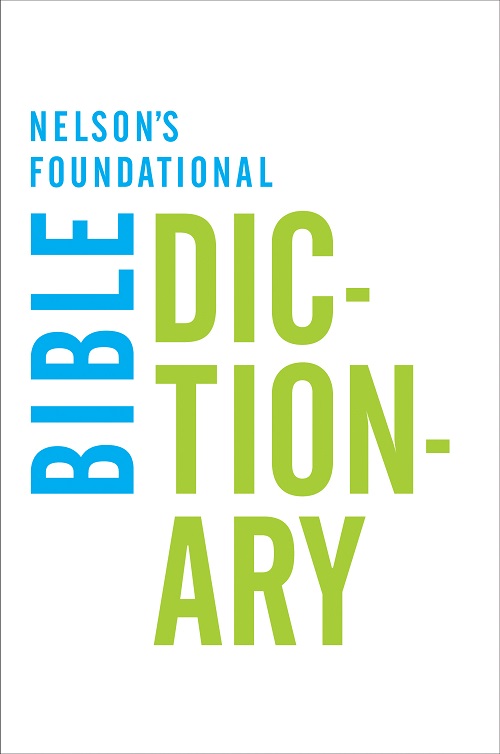
Nelsons Foundational Bible Dictionary
Katharine Harris

2004 by World Publishing.
All rights reserved. No portion of this book may be reproduced, stored in a retrieval system, or transmitted in any form or by any meanselectronic, mechanical, photocopy, recording, scanning, or otherexcept for brief quotations in critical reviews or articles, without the prior written permission of the publisher.
Published in Nashville, Tennessee by Thomas Nelson. Thomas Nelson is a registered trademark of HarperCollins Christian Publishing, Inc.
Thomas Nelson titles may be purchased in bulk for educational, business, fund-raising, or sales promotional use. For information, please e-mail SpecialMarkets@ThomasNelson.com.
All Scripture quotations are taken from the New King James Version. 1982 by Thomas Nelson. Used by permission. All rights reserved.
The Open Bible, Expanded Edition, New King James Version 1985, 1983 Thomas Nelson, Inc.
Dicksons Analytical Study Bible 1973, 1971, 1966, 1964, 1950, 1947, 1941, 1938, 1931 by John A. Dickson Publishing Company.
Illustrations 2004 www.clipart.com
eISBN: 9780529106292
Previously published as Worlds Bible Dictionary, ISBN 0-529-1-1902-1
Contents
Thank you for purchasing the HarperCollins Christian Publishing eBook version of Nelsons Foundational Bible Dictionary.
What is the difference between an eBook and a print book?
eBook versions contain all of the content and supplementary materials found in the original print versions and are optimized for navigation in the various apps and devices used for display. eReaders recognize text as one fluid string and are formatted in a single column. eReaders currently do not support the more complex layout seen in print version books. Therefore, some content may not appear in the same place as in the original print version, but it is structured consistently and uses hyperlinks to navigate between related content.
In addition to the full Dictionary materials, the eBook version of Nelsons Foundational Bible Dictionary also contains an of the full text of the New King James Version Bible. All verse references in the Dictionary are linked to that verse in the Bible so that you can easily navigate between the Dictionary and Bible text.
How do I use the eBook Table of Contents?
*Important Note: Be sure to consult your device manufacturers Users Guide for device-specific navigation instructions.*
The is the primary navigation anchor to quickly access various parts of the eBook. It is generally formatted in the same order as the original print version and is hyperlinked as follows:
, with alphabetical quick links
(full text Bible)
Selecting a main .
Using the Dictionary
Select the hyperlinked letter of the alphabet in the to go to the corresponding word list.
Use the devices Next Page/Previous Page buttons or functions to scroll through the entries. Select a word to go to that specific entry in the dictionary.
Select the Bible reference hyperlink to go to the corresponding Bible verse. To return to the Dictionary entry from the Bible text, use your devices back button or function.
To return to the alphabetical word list, select the specific word entry.
To return to the main from the alphabetical word list, select the letter heading (A).
Using the Bible Appendix
hyperlinks quickly access individual Bible books and chapters in each testament.
Book links go directly to the beginning of the book.
Chapter links go directly to the beginning of the chapter associated with a book.
Every Bible book and chapter hyperlink in the main text returns or goes back to the chapter listing.
Use the devices back button or function to go back to the last selection.
Using the chapter listing to navigate to specific Bible verses:
Navigate to and select a specific book of the Bible from the chapter listing.
Select a chapter number hyperlink.
Use the devices Next Page/Previous Page buttons or functions to scroll through the verses.
Use the devices back button or function to go back to the last selection.
For thousands of years, the Bible has fascinated, puzzled, and inspired the human race. It has sold more copies and been translated into more languages than any other book. It is read by the devout and the skeptical, believers and seekers, those who base their lives on its words and the merely curious. It carries a message so simple that a little child can grasp its meaning, and yet it is so deep and wide and high and long that the most brilliant person can spend a lifetime studying it and never plumb its depths.
The Bible was written for people to read, to ponder, and to understand. The message of Gods love for humans transcends time, culture, and language; it comes through loud and clear. Nevertheless, readers of the Bible are often left with questions. The names sound strange to our ears, the geography is often unfamiliar, and we ask, Who was this person? Is he mentioned somewhere else in the Bible? When did this happen? Where did it happen? Is this a real city? Why did this matter enough to write it down?
Nelsons Foundational Bible Dictionary seeks to answer questions like these, and many more. Included are summaries of each book of the Bible, a biographical sketch of the human author, historical background information concerning the time the book was written, and an outline of the structure of the book. Every person mentioned in the Bible can be found, with a selection of biblical references and pertinent biographical information. The many animals and minerals in the Bible are listed and defined, and the modern equivalents of ancient geographical names are given where possible. Many key theological terms, which may or may not be specifically mentioned in the Bible, are also listed, with discussions of their various meanings and interpretations. Common household items and occupations are included, with cultural and historical information about life in ancient times. The spelling of names and places follows the King James Version.
Nelsons Foundational Bible Dictionary is designed to be a practical, easy-to-use reference tool for ordinary people. Without being exhaustive, or trying to take the place of a concordance, it gives the reader a wide, comprehensive source for answering the Who? When? Where? and How? questions that come up when reading Gods Word.
K ATHARINE H ARRIS
Old Testament
New Testament
AV | Authorized Version |
B.C. | Before Christ |
c. | approximately |
cf. | compare |
ch., chs. | chapter, chapters |
A.D. | After the Lord |
KJV | King James Version |
lb., lbs. | pound, pounds |
LXX | Septuagintancient Greek OT translation |
NASB | New American Standard Bible |
NEB | New English Bible |
NIV | New International Version |
NKJV | New King James Version |
NRSV | New Revised Standard Version |
REB | |
Next page
